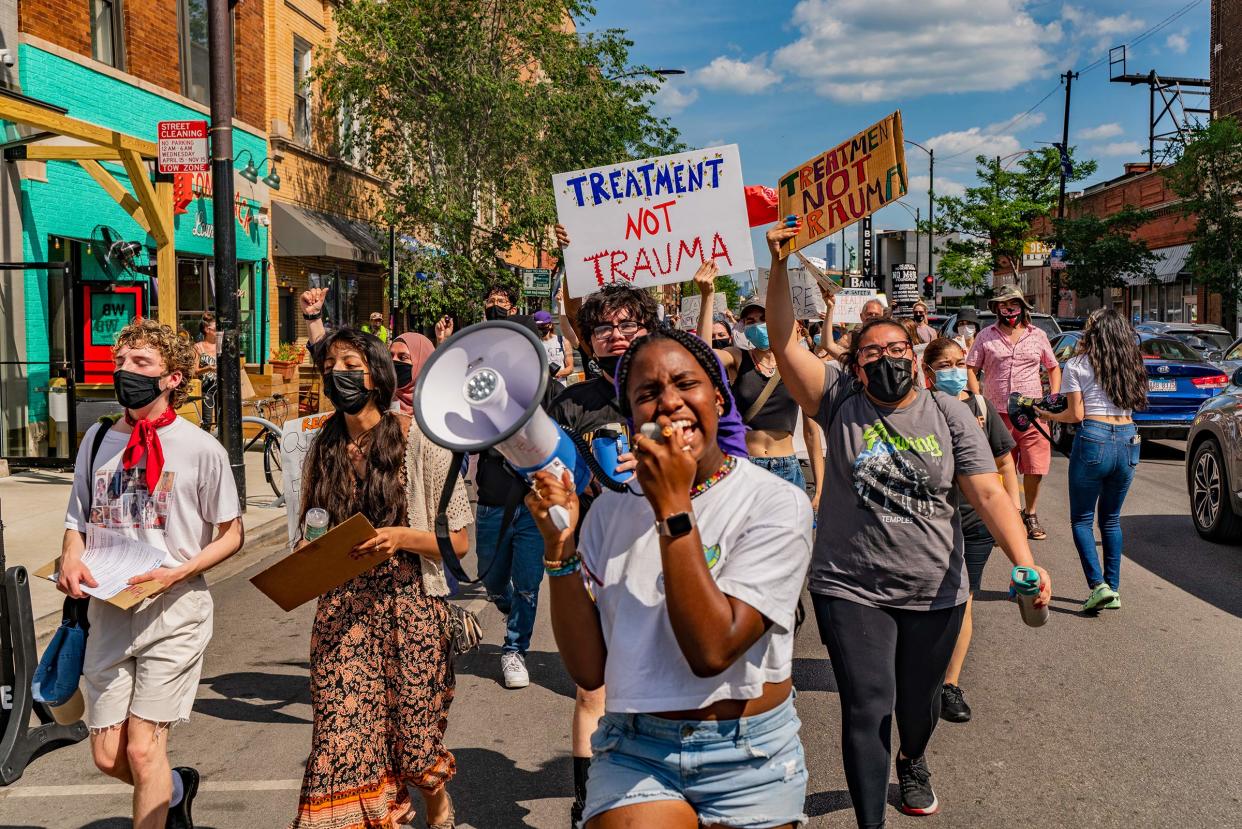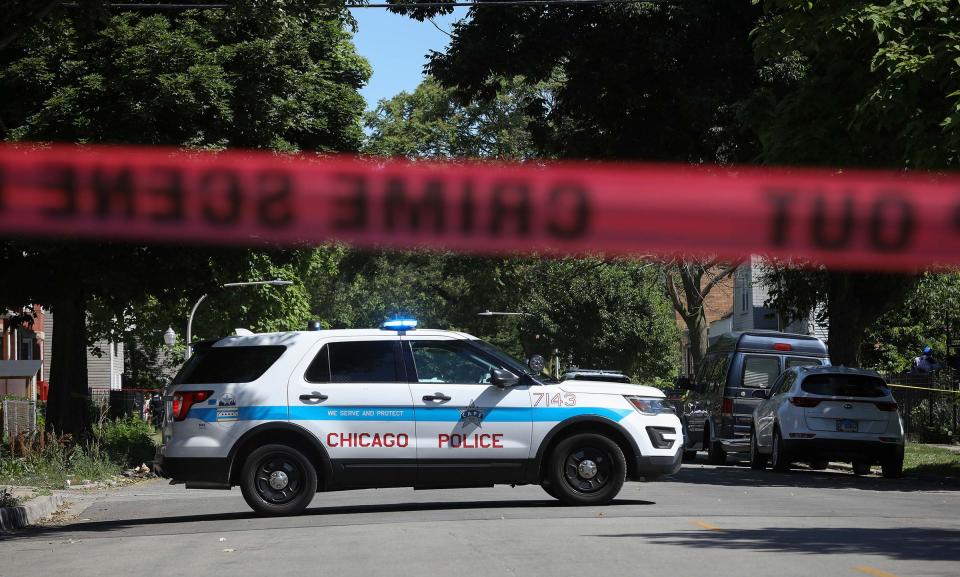How to Really Stop Police Brutality

Youth organizers for Treatment Not Trauma in Chicago. Credit - Oscar Sanchez
On a Wednesday afternoon last March, 19-year-old Win Rozario called 911 for help. Win was inside his family home in Queens with his mother and younger brother, Utsho. Two New York City Police officers arrived within two minutes. Utsho let them in the door, asking them to “be gentle” with Win, who was experiencing a psychotic episode like those he had had before and for which he had been hospitalized during the previous year. Recently released body camera footage shows the officers, who were trained by NYPD in responding to mental health calls, were anything but gentle.
Police claimed that when they went to take Win into custody to transport him to a mental health facility, he grabbed a pair of scissors and charged at them. Utsho told the New York Times that their mother was hugging Win at the time, trying to comfort and calm him. The officers tasered Win. His mother continued to hug him and took the scissors from him; police say she also detached the Taser prongs from his body—something the body cam footage could not prove. According to Utsho, whose account differed from the police narrative, “my brother didn’t really go down. So one of the cops pulled out a gun and shot him as my mother was still hugging him.” Both officers then fired multiple rounds at Win, who was taken by medical responders to a hospital, where he was pronounced dead. Body camera footage now shows that what transpired deviates from what police initially claimed and gives little indication that Win posed an imminent threat to the officers that could justify repeatedly shooting and killing him.
This nightmarish scene is not isolated. Approximately one fifth of all people killed by U.S. police officers in the line of duty since 2015 were suffering—or perceived to be suffering—from a mental health crisis. People diagnosed with severe mental illness are 16 times more likely to be killed by law enforcement. The number may well be higher: recent research shows killings by police have gone unreported in official statistics in over half of all cases from 1980 to 2019.
Despite widespread promises of police reform in recent years, killings by police show no sign of abating. In 2023, U.S. police officers killed at least 1,247 people—more than in any other year in over a decade. These killings are symptoms of a disease born of investing in reactive police and punishment instead of violence prevention and supportive services—an approach that President Biden is now once again seeking to deepen by calling for federal funding to hire 100,000 more police officers.
Chicago provides an exemplary case study of the consequences of such investments, and how American cities might now change course. The City paid out $295 million between 2019–2022 to settle over 500 cases involving more than 1,000 police officers accused of misconduct, which is more City money than it budgeted for the entire Chicago Department of Public Health (CDPH) over this same period. This is reflective of a pattern in which the Police Department, long relied upon by lawmakers as a catch-all agency for responding to mental health, social, and economic crises, has built an unusually pronounced legacy of corruption, torture, racist brutality, and far-right extremist group affiliations.
It is fully appropriate to condemn CPD for this reality and its ongoing failure to institute meaningful reforms, despite a federal consent decree imposed in 2019 in the wake of repeated killings by Chicago police. (CPD has fully complied with just 6% of the reforms required by the consent decree.) It’s also important to see that CPD has been set up to fail and that officers’ behavior is unlikely to change unless reforms are made not just internally but also to the City’s budgetary decisions, specifically to chronic overinvestment in police alongside underinvestment in CDPH—now one of the most defunded large-city public health departments in the country.
There is now very little supportive infrastructure left to prevent or respond to the manifestations of poverty, desperation, ruptured social fabric, and healthcare exclusion that particularly affect Chicago’s Black and Latinx neighborhoods. In times of need, residents have few options but to request police who—despite wildly inappropriate training for the role—are effectively required to fill in as community mental health workers.

The thousands of calls with a mental health component that CPD responds to each month generate widespread frustration among officers, who feel that they are forced to address social and medical problems for which they are not trained and that care systems should be managing instead. In this context, police officers are widely demoralized. Hiring has become increasingly difficult. According to a August 2023 report, CPD there were 1,730 open positions, most of which have remained unfilled for years. (Yet even with these vacancies, CPD features the second-highest number of officers per capita and the second-highest per capita police budget among large U.S. cities.)
After years of labor by a coalition of community organizers known as the Collaborative for Community Wellness, an innovative policy meant to address the shortcomings of CDPH and the overburdening of CPD is finally on the verge of implementation. Treatment Not Trauma, which one of us (ER) has worked with the Collaborative to design, seeks to rebuild a CDPH-run community care system so as to remove response to mental health and behavioral crises from CPD’s plate. It is a transformative policy that revolves around three interdependent parts: non-police crisis response systems, community mental health centers and crisis triage facilities, and a transformative model of mental health delivery led by community care workers. Mayor Brandon Johnson has embraced TNT as one of his signature policy priorities and just announced the first steps toward its implementation.
As explained in the white paper, TNT would build on non-police crisis response programs that have been successfully implemented in other cities like Denver, Atlanta, San Francisco, Pittsburgh, and even New York City. But TNT goes well beyond them to apply a public health model of mental health that begins from the recognition that crisis response works best, and is needed least, when interwoven with crisis prevention systems based on supportive community ties. TNT is thus designed around hiring, training, and properly compensating nonprofessional mental health workers from within communities to work in task-sharing collaboration with professional ones. The upshot would be a non-police mobile crisis response system and a better ability to prevent crises in the first place.
Such public-health approaches to community mental health that invest resources in employing and training lay community members to provide care to one another have been profoundly underutilized in the U.S., dominated as it is by a notoriously ineffective, inefficient, and deeply corrupted healthcare industry. But there is abundant evidence from international contexts of their effectiveness and importance, especially in the face of the dearth of existing services and professionals seen in Chicago’s highest-need neighborhoods.
To house and support this work, TNT envisions reopening 14 City-run mental health centers, returning the total number of such centers to 19. They will operate as 24-hour walk-in service, crisis reception and stabilization, and home bases for community outreach care worker teams. Taking a more holistic view, these hubs are also meant to function as places for community gatherings to rebuild social fabric in historically dispossessed neighborhoods.
Will it work? Based on evidence from cities that have implemented parallel agendas, TNT can be expected to reduce the dependence on overburdened police, hospital emergency departments, and inpatient psychiatric beds. In the process, the city would enable meaningful change—and savings.
One study found that mobile crisis intervention services reduced inpatient hospitalization costs by 79% over the six months following each crisis call. A related study, which evaluated only initial expenses, found a 23% savings. A more comprehensive evaluation estimates that a program for non-police crisis response like TNT would yield a $537 million savings in Cook County, or $279 million when restricted to Chicago alone. Actual savings may be greater, as TNT is more ambitious than the crisis-response model that the figure is based on.
From a criminal-legal perspective, nearly every study evaluating preventative measures finds substantial benefits. A study of Denver’s recent adoption of a TNT-like approach, for example, reduced low-level crimes by 34% (while observing no increase in more serious crimes).
It’s no surprise, then, that TNT is backed by the public. In November 2022, a referendum was introduced on the ballot in three wards asking residents if they supported reopening Chicago’s previously existing 19 City-run mental health centers and dispatching mental health teams rather than police to respond to mental health emergencies. The measure passed with a staggering 93% approval. And a survey exploring community visions for mental health crisis response among 652 Chicagoans across all wards of the city found that over three quarters (77%) of respondents believed that police should not have a role in responding to mental health crises.
TNT’s popularity among voters is not in doubt. What remains to be seen is whether the Johnson administration will ultimately make the major investments needed for TNT to be successful. After including a substantial increase in police funding in his first budget alongside a comparatively static City allocation for public health, Johnson has displayed a penchant for compromise with the same failed policing paradigms that he campaigned against. This has alarmed local organizers and given them reason to doubt his commitment to TNT, particularly to the work of building the community care corps around which TNT revolves.
One of the biggest barriers to realizing TNT’s full potential arises from the misperception of what TNT means for the police. Far from a threat to improved policing and safety, TNT would function as an enormous asset for a flailing police administration that has, for decades, been unable to reform itself. If Chicago continues to rely on police to serve as de facto community health workers, both officers and communities will continue to suffer. The fact is, police reform is too important and too difficult to leave to police alone. Meaningful reform will require investing in supportive systems beyond policing that can, in turn, shrink the outsized footprint of police and punishment in American society.
TNT isn’t just about protecting people living with mental illness, nor only about building a way out of the current cycle of living from crisis to crisis. It’s also about no longer setting up police officers as scapegoats for the fallout of decisions to defund care systems. TNT is about finally following the evidence and making a decision to invest in the supportive infrastructure for violence prevention that we all—police officers included—need to be able to live safely and fully together, rather than in constant fear of one another.
Chicago has an opportunity to lead the way for the entire country in refusing to simply lament the seemingly endless series of preventable killings by police and to, instead, finally implement policies adequate to stop them.
Contact us at letters@time.com.
